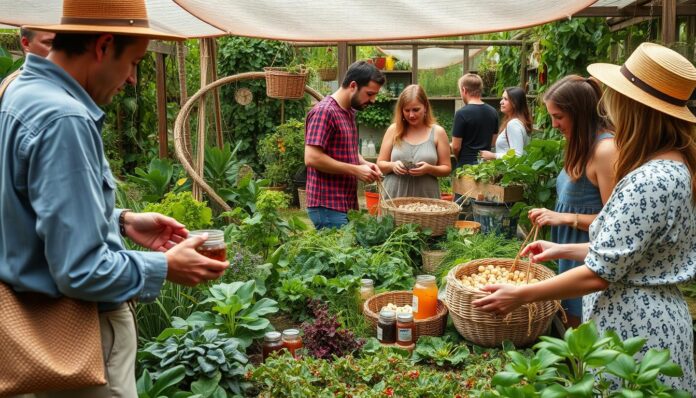Did you know bartering can be a good alternative when money is tight? This is true during times of high inflation or economic downturns. It shows how important bartering is in permaculture and sustainable economies. Permaculture is a way to live that combines ethics, principles, and techniques from different farming systems. It aims to create a sustainable, self-regulating ecosystem where bartering is key.
Learning about permaculture and bartering can help you live more independently. It’s a step towards a more sustainable future. Permaculture isn’t just about farming anymore. It’s about creating a permanent culture in many areas, including emotional, social, economic, and technological ones. Bartering systems support these efforts.
Introduction to Permaculture Barter Systems
Permaculture barter systems are about trading without money. This is a big part of sustainable economies. It helps reduce waste, promotes recycling, and encourages diversity in food, skills, and species. These are core principles of permaculture and bartering.
Key Takeaways
- Permaculture barter systems can serve as an alternative in times of monetary crisis
- Permaculture emphasizes sustainability by striving for systems that produce zero waste
- Permaculture barter systems can help reduce waste and promote energy cycling
- Permaculture encourages diversification in food sources, skills, and species
- Permaculture barter systems can help create a self-reliant lifestyle and build a more sustainable future
- Permaculture barter systems are a key aspect of sustainable economic models
- Permaculture barter systems can help promote community connections and resource optimization
What is Permaculture?
Permaculture is a way to design a sustainable ecosystem. It follows key principles like observing nature and getting a yield. This approach helps us live more sustainably. Community exchange networks and organic trade networks are key, letting us share resources and skills.
Permaculture offers many benefits. It boosts carbon stocks, soil quality, and biodiversity. Studies show it can increase native species by 50%. It also encourages community engagement and cuts down industrial reliance by 40%.
Permaculture is seen as a better choice than traditional farming. It can grow 20% more food per area with multiple species. It also saves water, reducing use by 10-20%.
Permaculture courses are now in over 100 countries. They focus on community exchange networks and organic trade networks. These networks help us share knowledge and skills, leading to a greener future.
Understanding Barter Systems
Bartering has been around for ages as a way to exchange things. It helps cut down on money use and brings people together. In the world of regenerative economy practices, bartering is key to a better, fairer economy. It works well with alternative currency systems to boost local economies.
Definition of Barter
Bartering means trading goods or services without money. It’s great when cash is hard to come by. It helps people be more self-sufficient and strong.
Historical Context of Bartering
Bartering has been around since ancient times. It’s used to swap food, clothes, tools, and even skills. It’s a way to get what you need without money.
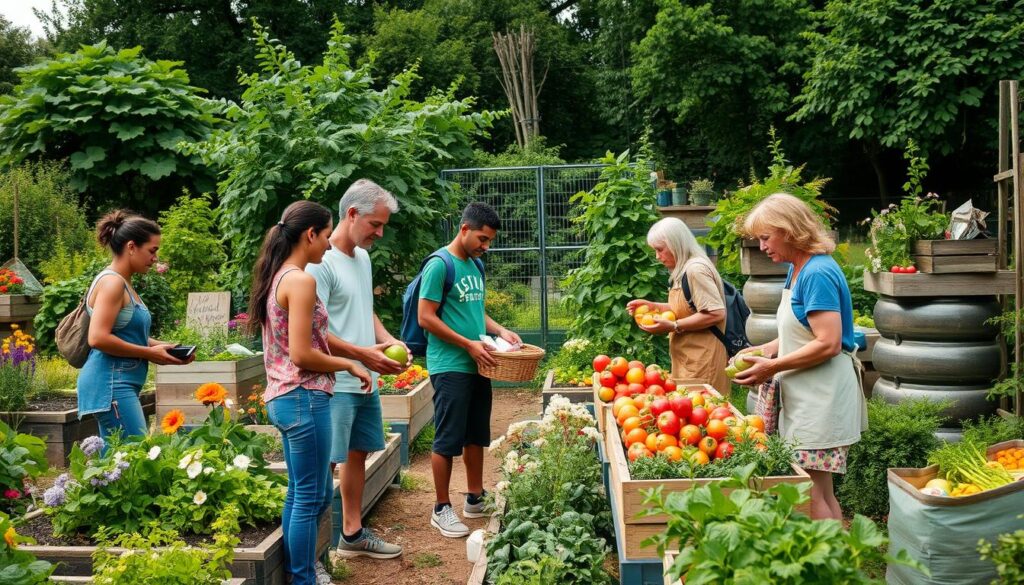
Advantages of Bartering
Bartering has many benefits. It cuts down on money use and brings people together. It also helps local businesses grow. Plus, it supports regenerative economy practices and alternative currency systems for a better economy.
- Reduces reliance on money
- Promotes community interaction
- Increases access to goods and services
- Supports local economic development
- Promotes regenerative economy practices
The Role of Bartering in Permaculture
Bartering is key in permaculture, helping people share resources and skills. This builds community ties. It’s a big part of mutual aid societies and local trading, which are vital for bartering.
By joining these systems, people can use less money. They also strengthen their bonds with the community.
Some main perks of bartering in permaculture are:
- It makes community ties stronger by exchanging goods and services
- It helps use resources better by sharing extra produce and skills
- It cuts down on waste by using items that would be thrown away
Studies show bartering helps a lot. For example, neighborhoods with repair cafés see more community involvement. They also find more joy in sharing.
By supporting bartering and mutual aid, we help build a better economy. Starting local trading is easy. Just trade extra food with farmers. It strengthens community bonds and fights for fairness.
| Benefit | Description |
|---|---|
| Community Engagement | Increases community participation and collaboration |
| Resource Optimization | Reduces waste by utilizing surplus produce and skills |
| Economic Justice | Promotes a more equitable economy through mutual aid and fair trade |
Key Components of a Barter System
A good permaculture barter system needs a few key things. These include exchanging goods and services fairly, valuing them right, and building trust. Together, they make a strong, green economic model that helps everyone. In this system, people swap things without money, making life more just and kind to the planet.
Some important parts of a barter system are:
- Goods and services exchange: This is the base of a barter system. People swap goods and services without money.
- Fair valuation: This makes sure everyone gets a fair deal for what they offer. It builds trust and cooperation.
- Trust building: Trust is key in a barter system. People must trust each other to keep their promises and offer quality stuff.
With these parts, permaculture barter systems can build a better, greener economy. They help make our lives and our world better. This way of living could change how we see each other and our planet.
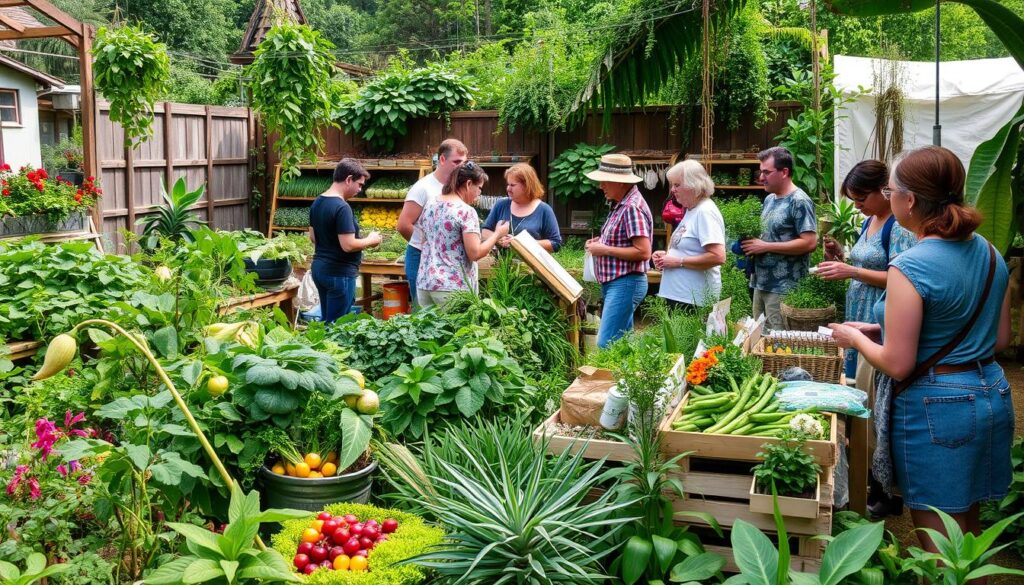
| Component | Description |
|---|---|
| Goods and services exchange | Exchange of goods and services without using money |
| Fair valuation | Ensuring all participants receive a fair value for their goods and services |
| Trust building | Establishing trust among participants to fulfill obligations and provide quality goods and services |
How to Set Up a Barter System
Creating a barter system needs careful planning. You must think about what the community needs and has. It’s important to know the skills and resources people have. Community exchange networks and organic trade networks help make these exchanges work.
To start, find out what skills and resources the community has. You can do this by asking people or having meetings. After you know what’s available, you can set up a network for trading.
Establishing Barter Networks
Building barter networks is key to a barter system’s success. These networks can be online or in person. They help people find others to trade with. Community exchange networks and organic trade networks make sure trades are fair.
Using Digital Platforms
Digital tools can help with trading in a barter system. They let people find others to trade with and track trades. Online marketplaces and social media groups are good examples.
| Platform | Description |
|---|---|
| Online Marketplaces | Provide a way for individuals to buy and sell goods and services |
| Social Media Groups | Provide a way for individuals to connect with one another and exchange goods and services |
Barter System Models in Permaculture
Permaculture has led to the creation of barter system models. These models are key for a regenerative economy. They use alternative currency systems and support sustainable living. This way, people can lessen their dependence on traditional money and build community ties.
Integrating regenerative economy practices into barter systems works well in many places. For example, cooperatives help share resources and skills, making wealth distribution fairer. Skill swaps are also gaining popularity, letting people trade services without money.
Community-Based Models
Community-based models aim to unite people and boost local economies. They often include community gardens where folks grow food and share it. This not only gives fresh produce but also strengthens community bonds.
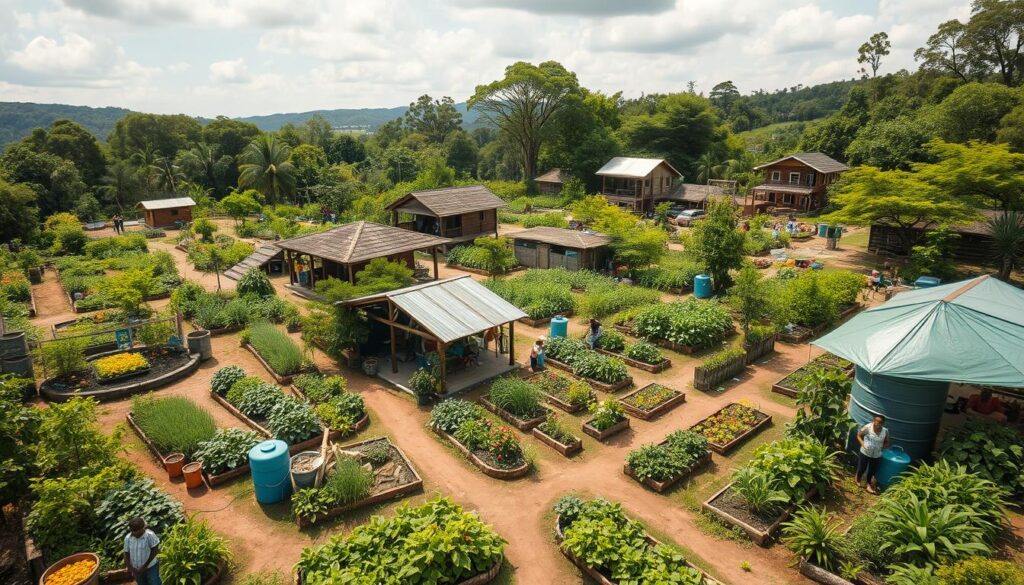
Cooperative Approaches
Cooperative methods involve working together to reach goals. In permaculture, they help create shared resources like tool libraries and kitchens. These shared spaces reduce the need for personal ownership, encouraging a greener lifestyle.
Skill Swaps
Skill swaps let people exchange services instead of goods. This way, skills and knowledge are shared fairly. Skill swaps cover a wide range of services, from education to healthcare.
Legal Considerations for Barter Systems
Setting up a barter system needs careful thought about legal matters. This ensures everything runs smoothly and safely. Groups like mutual aid societies help make bartering fair and beneficial for everyone.
Some important things to think about include:
- Tax rules: Barter systems must follow tax laws to stay out of trouble.
- Contracts: It’s vital to have clear contracts that cover all the details of the exchange. This protects everyone involved.
- Handling disputes: Having a way to solve problems is key. It keeps trust and fairness in the system.
Knowing these legal points helps make a barter system work well. It helps the community and supports local trading. Mutual aid societies can offer help and advice on legal aspects of bartering.
| Legal Consideration | Importance |
|---|---|
| Tax Compliance | High |
| Contractual Agreements | Medium |
| Dispute Resolution | Low |
Successful Examples of Barter Systems
Permaculture barter systems are key to sustainable economies. They help create fair and green economies. Examples include local food swaps, tool libraries, and skill shares. These systems build community and share resources, cutting down on money transactions.
For example, permaculture practice helps create water harvesting systems. These can be shared through barter, saving water and fostering cooperation.
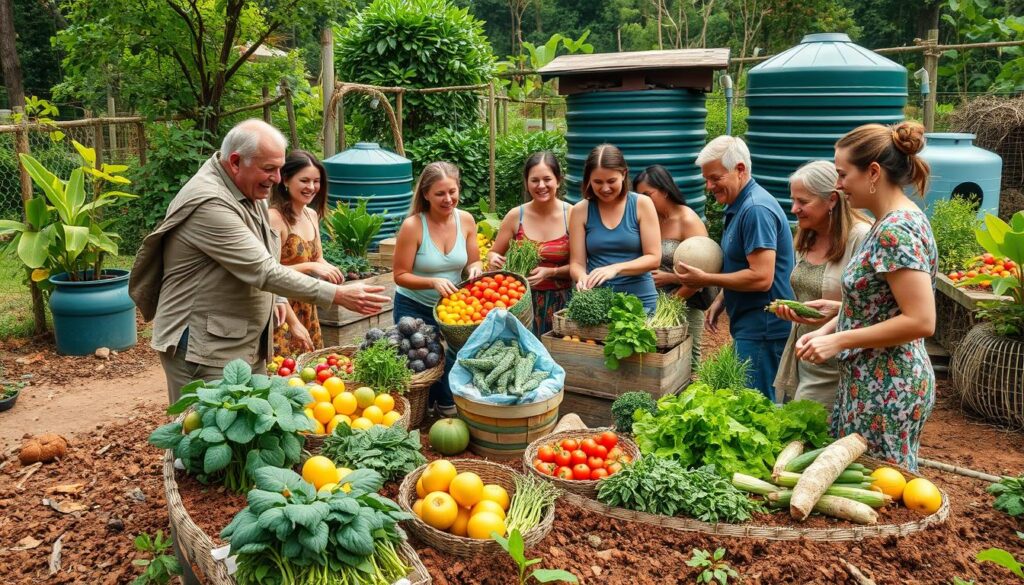
Case Study: Local Food Swaps
Local food swaps show permaculture barter systems in action. People exchange fresh, local produce. This cuts down on industrial farming and supports green food systems.
Case Study: Tool Libraries
Tool libraries are another success story. They let people borrow tools, reducing the need for personal ownership. This promotes sharing resources.
Case Study: Educational Skill Shares
Educational skill shares share knowledge and build skills. They let people teach and learn new things. This boosts personal growth and community development.
Resources for Barter Systems
Setting up a good barter system needs the right tools. Community exchange networks and organic trade networks are key. They help people swap goods and services, building a strong community.
There are many tools to help with barter systems. Online platforms, local boards, and educational materials are some. They help people find each other, share info, and make friends. With these tools, communities can grow strong barter systems that help everyone.
Online Platforms
Online platforms make it easy to meet and trade. You can post what you have, ask for what you need, and talk to others. Sites like social media groups, forums, and barter websites are popular.
Local Community Boards
Local boards are also great for barter systems. They let you post ads, share services, and meet locals. Some are physical, while others are online or on social media.
Education and Training
Learning is key for a good barter system. Knowing about community exchange and organic trade helps. You can learn about permaculture, organic gardening, and living green.
With these resources, you can build a strong barter system. It’s all about working together and being sustainable. Online, local boards, or learning more are all good ways to start.
Challenges of Barter Systems
Barter systems are good for communities and people, but they have big challenges. One big problem is value discrepancies. This means the value of what’s exchanged might not be seen as equal. This can cause unfair trades and make people unhappy.
Another issue is lack of community participation. This means there are fewer resources and skills to trade. To fix these problems, alternative currency systems and regenerative economy practices can help. They make for a more sustainable and fair economy.
Some main challenges of barter systems are:
- Value discrepancies
- Lack of community participation
- Quality control issues
Knowing these challenges helps make a barter system work well. It benefits the community and supports regenerative economy practices.
The success of barter systems depends on solving these challenges. We need a fair, sustainable system that helps everyone. This is done with alternative currency systems and regenerative economy practices.
| Challenge | Description |
|---|---|
| Value Discrepancies | Perceived value of goods or services exchanged may not be equal |
| Lack of Community Participation | Limited pool of resources and skills available for exchange |
| Quality Control Issues | Difficulty in ensuring the quality of goods or services exchanged |
Best Practices for Permaculture Bartering
Permaculture bartering is about trading without money. It helps build mutual aid societies and local trading initiatives. To make it work, clear communication, rules, and strong relationships are key.
Here are some tips for successful permaculture bartering:
- Make sure everyone knows what they’re getting and giving.
- Find a fair way to value what’s being traded.
- Focus on teamwork and helping each other out.
By using these tips and joining in on 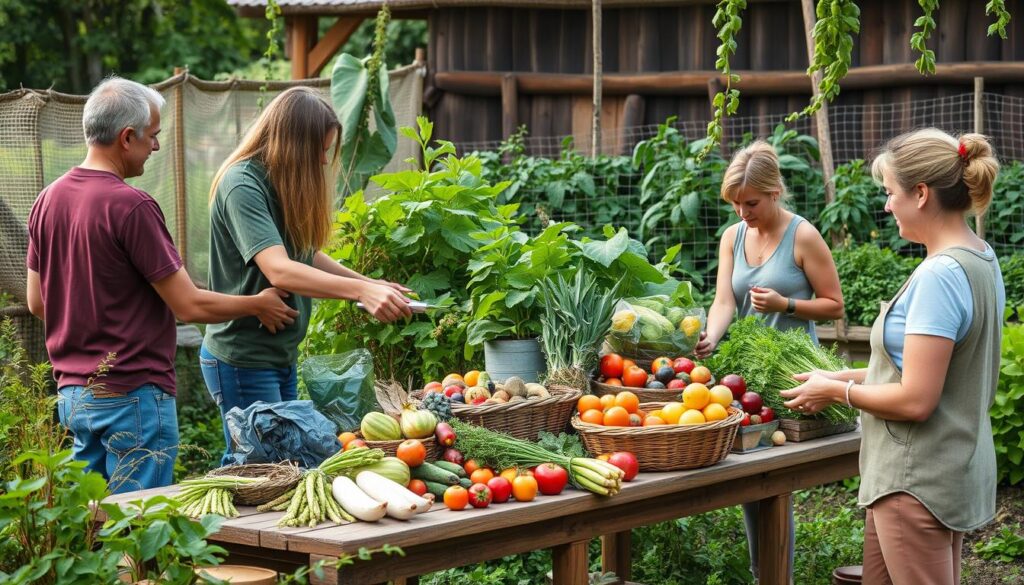
Permaculture bartering also cuts down on waste and supports local life. It makes communities stronger and more self-sufficient.
| Benefits of Permaculture Bartering | Description |
|---|---|
| Reduced waste | Trading goods and services means less need for new, resource-heavy items. |
| Promoted biodiversity | Supporting local diversity helps keep unique species and ecosystems alive. |
| Supported local economies | Keeping resources local boosts local growth and development. |
Bartering and Ecological Sustainability
Permaculture barter systems are key to ecological sustainability. They help reduce waste, boost biodiversity, and support local economies. Sustainable economic models are vital for these systems to work well. They let people trade goods and services without using money.
Some key benefits of permaculture barter systems are:
- They cut down on waste by exchanging goods and services that would be thrown away.
- They help biodiversity by backing local farmers and producers.
- They keep money in the community by supporting local economies.
Joining permaculture barter systems helps build a more sustainable and fair economy. These systems are crucial for ecological sustainability. They lead to less waste, more biodiversity, and stronger local economies.
The Future of Barter in Permaculture
The future of barter in permaculture is bright. Trends in local economies and new ways to barter are emerging. Community exchange networks and organic trade networks are key. They help people share resources and skills.
By understanding these trends, we can build a strong barter system. This system will benefit our communities.
Some key features of the future of barter in permaculture include:
- Increased use of community exchange networks to facilitate the exchange of goods and services
- Growing importance of organic trade networks in promoting sustainable agriculture and reducing reliance on industrial agriculture
- Role of technology in enhancing bartering practices and connecting individuals with similar interests
As the world’s population grows, we need sustainable food systems more than ever. Bartering and community exchange networks are vital. They help local economies and reduce waste.
By adopting these practices, we can help create a sustainable future. We can make the world a better place for ourselves and our communities.
| Feature | Importance |
|---|---|
| Community exchange networks | High |
| Organic trade networks | High |
| Role of technology | Moderate |
Conclusion: Embracing Barter in Permaculture
Barter systems in permaculture bring many benefits to individuals and communities. They help us create a more sustainable and fair economy. By using alternative currency systems and regenerative economy practices, we can build a better world. Bartering lets us trade goods and services without money, fostering community and cooperation.
Some key advantages of bartering in permaculture include:
- Reduced waste and pollution
- Increased food security and access to fresh produce
- Support for local economies and small-scale farmers
- Opportunities for skill-sharing and knowledge exchange
By adopting regenerative economy practices and alternative currency systems, we can make our food system stronger and more sustainable. It’s crucial to keep exploring and improving these systems. We must make sure they help everyone in our communities.
Looking ahead, bartering and alternative currency systems will be key in shaping our economy and food systems. By embracing these practices, we can build a fairer and more sustainable world. A world where everyone has what they need to succeed.
| Benefits of Bartering | Description |
|---|---|
| Reduced waste and pollution | Bartering promotes the reuse and recycling of materials, reducing waste and pollution. |
| Increased food security | Bartering provides access to fresh produce and supports local food systems. |
| Support for local economies | Bartering supports small-scale farmers and local businesses, promoting economic growth and development. |
Additional Reading and Resources
If you’re curious about bartering and permaculture, there’s a lot to learn. You can find books, articles, online forums, and workshops. These resources can help you understand these topics better.
Recommended Books and Articles
Check out “The Gift: The Form and Reason for Exchange in Archaic Societies” by Marcel Mauss. Also, read “Permaculture: A Designers’ Manual” by Bill Mollison. These books offer deep insights into bartering and permaculture.
For the latest news, read articles in “Permaculture Magazine” and “Shareable”. They cover mutual aid societies and local trading initiatives.
Online Forums and Communities
Join online groups like “Permaculture Voices” and the “Mutual Aid Societies” subreddit. These places are great for meeting others who share your interests. You can learn a lot and get inspired to start your own barter system.
Workshops and Training Sessions
Look for workshops and training sessions on bartering and permaculture. These hands-on events can teach you how to set up barter networks. They also cover managing fair valuations and integrating bartering into sustainable living.
Check out events hosted by local permaculture groups or community centers. They’re a great way to start learning.

